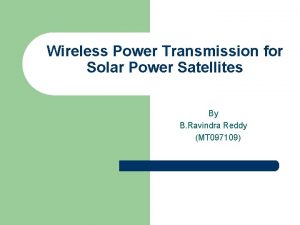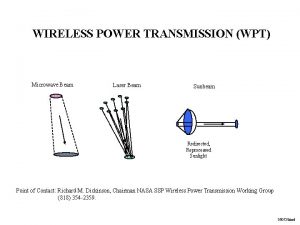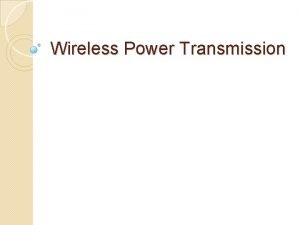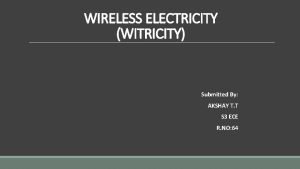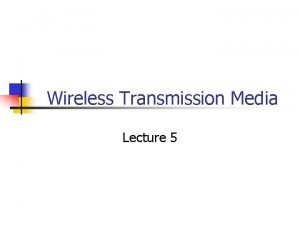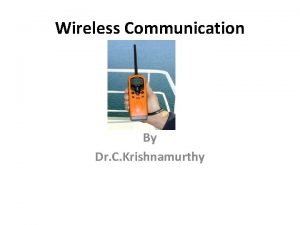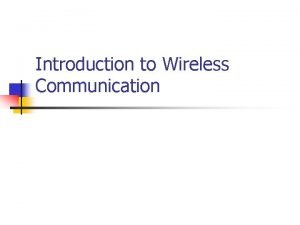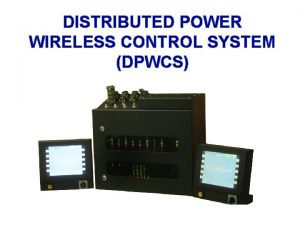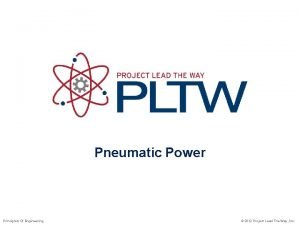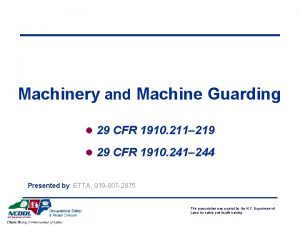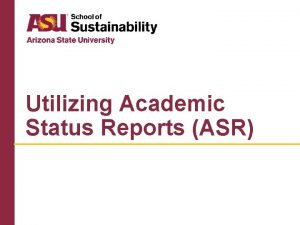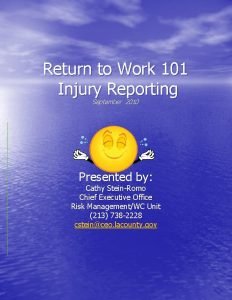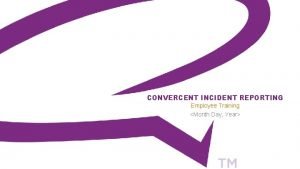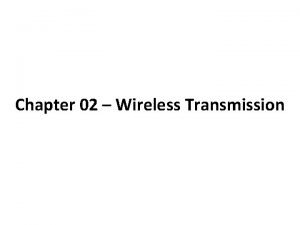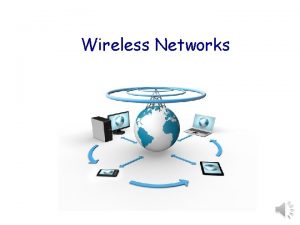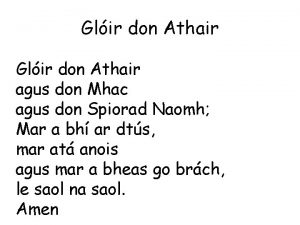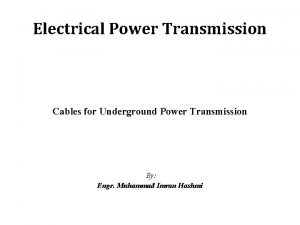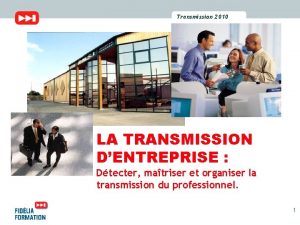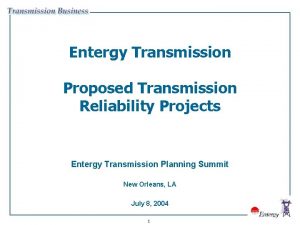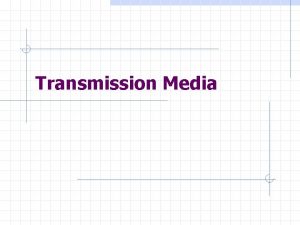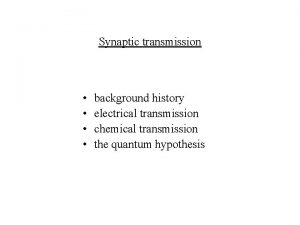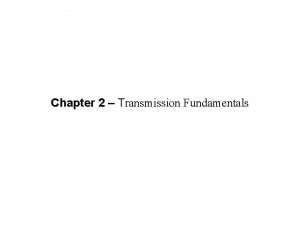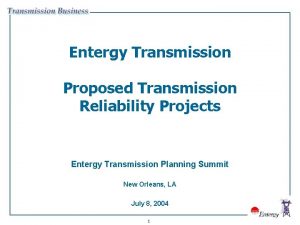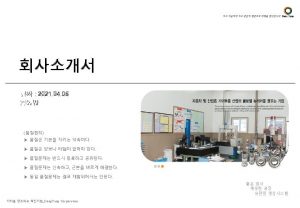Wireless Power Transmission WPT A status report Don




















- Slides: 20

Wireless Power Transmission – WPT A status report Don Beattie, G 3 BJ

Topics • What is happening? • What is WPT? • What are the plans for WPT? • What are the technical characteristics of WPT? • What problems could this create? • What action is needed?

ITU – what is happening (1)? Question 210 -3 (January 2013): 1 2 3 Under what category of spectrum use should administrations consider WPT: ISM, or other? What radio frequency bands are most suitable for WPT? What steps are required to ensure that radiocommunication services, including the radio astronomy service, are protected from WPT operations?

ITU – what is happening (2)? WRC 19 agenda Item 9. 1. 6: Studies concerning Wireless Power Transmission (WPT) for electric vehicles: a) to assess the impact of WPT for electric vehicles on radiocommunication services; b) to study suitable harmonized frequency ranges which would minimize the impact on radiocommunication services from WPT for electrical vehicles.

What is WPT? • Is it a “Short Range Device” ? • Is it ISM (Industrial, Scientific and Medical) • Different spurious emission “rules” for each. • SRD -> defined by CEPT and ITU emission limits • ISM -> defined by CISPR limits • Both are similar, and inadequate • This uncertainty is making the issue of spurious emissions a complex process and manufacturers are likely to argue for the route which demands the least strict limits

What’s happened? Intensive work in CISPR, CEPT and ITU. Some work in other RTOs CEPT Report 289 Various draft recommendations in ITU Arguments in CISPR about calculation of emission limits Although there are differing views on how to treat WPT: SRD or ISM, in both cases no change felt necessary in Radio Regulations • BUT……. this only concerns the operating frequency of WPT • The real problem is the spurious emission level from WPT • • •

Signal-to-noise ratios in the amateur service 40, 00 Based on 528, 000 data points over a 2 x 24 hour period between 1. 8 -30 MHz 35, 00 30, 00 % of stations 25, 00 20, 00 The amateur service is therefore highly susceptible to any increase in the background noise level. 15, 00 10, 00 5, 00 0, 00 5 15 25 35 S/n ratio in 500 Hz bandwidth A 1 A mode 45 55 56 75

What is WPT? • Wireless charging of a range of devices at varying power levels • Frequencies being planned: • • 19 -21 k. Hz for high power 55 -65 k. Hz for medium power (but some concerns) 79 -90 k. Hz for medium power 100 -148. 5 k. Hz for lower power (but still up to 2. 4 k. W!) • Currently all subject to spurious limits at ERC Rec 7401/SM. 329/CISPR 11 levels

What is WPT(EV)?

WPT(EV) in the home environment • Charges the car through induction via a pad under the vehicle, rather than “plug-in” • Power levels from 3. 3 to 22 k. W • Likely to operate around 85 k. Hz. The harmonics could cause severe interference to local radio reception – both amateur and broadcast. • Charge times of 3 -12 hours • 64 installations per km 2 (=never more than 88 m from one) • Frequency stability and phase noise uncertain • CEPT intends to classify as a “Short Range Device” (SRD) • SRDs & ISM are not permitted to cause interference to radio services! But what is “interference”?

What is WPT (Generic)? • In-home devices for charging a range of devices: • Mobile phones and accessories, cameras, AV equipment • Power tools, laptops, lighting, household devices, furniture, television, robots (both domestic and industrial), healthcare, e-bikes, drones, garden equipment • Kitchen appliances (blender, rice-cooker, fryer, mixer), lighting, kitchen countertops • Mainly long-duration charging • High density of deployment (6, 500/km 2) • Generally 100 -148. 5 k. Hz

Projected MINIMUM spurious emissions - EV Frequency -Adjustment > 30 m (d. B) Level at 62. 5 m cf 10 m (d. B) Level at 88 m cf 10 m (d. B) Absolute level @ 88 m with emissions at 10 m @ ITUR SM. 329 d. BµA/m d. B above background noise @ 88 m (residential/rural) d. B above background noise @ 30 m (residential/rural) 900 k. Hz -27. 5 -46. 6 -49. 6 -40. 6 7. 2/3. 1 29. 3/25. 2 1. 6 MHz -26. 0 -32. 4 -35. 4 -28. 8 8. 4/14. 4 27. 8/33. 8 1. 8 MHz -25. 5 -32. 4 -35. 4 -29. 4 8. 8/13. 8 18. 7/23. 7 5 MHz -18. 2 -24. 4 -27. 4 -25. 8 15. 5/21. 5 24. 7/30. 7 10 MHz -10 -16. 3 -19. 3 -20. 3 24/29 33. 3/38. 3

Projected MINIMUM spurious emissions - generic • Generic WPT • Installed density projected means maximum distance from a WPT installation is 10 m in urban areas. So minimum spurious emission is at ERC 74 -01 level – about 40 d. B above background noise if equipment “just” meets the 74 -01 specification. • In 78% of cases the emissions will be 9 d. B above ERC 74 -01 levels • However, data from Apple suggests emissions from tested devices may be as good as – 30 d. B ref ERC 74 -01 - closer to the IARU requested levels

SRD • In the past, Short Range Devices in the home environment have been: • Low power, and/or • Short duration transmission • WPT is neither • Some have suggested that existing spurious emission limits for inductive SRDs are appropriate. • CISPR limits assume intermittency and distance spacing, which do not apply to WPT. • WPT is generally high duty cycle, located in residential areas and its harmonics are likely to be spread across a band of frequencies in comes cases the whole of the HF spectrum

The CEPT / ITU limits and the noise level Note limits are some 40 -60 d. B above noise level at 10 m distance. CISPR 11 is similar (not shown). This is also the generic WPT MINIMUM impact level WPT EV MINIMUM impact of spurious emissions (@88 m) Recent measurements in UK on noise levels and other reports submitted to ITU suggest that, with the exception of a few “hot spots”, the ITU-R P 372 levels are still a reasonable assessment of the real world

Modelled harmonic field strength WPT-EV

Modelled harmonic field strength WPT-EV

WPT at these limits will severely impact radio reception • EC Decision 2006/771/EC states: Member States shall designate and make available, on a non- exclusive, non-interference and non-protected basis, the frequency bands for the categories of short-range devices. ‘Non-interference and non-protected basis’ means that no harmful interference may be caused to any radio communications service • ITU RR 15. 13 states Administrations shall take all practicable and necessary steps to ensure that radiation from equipment used for industrial, scientific and medical applications is minimal and that, outside the bands designated for use by this equipment, radiation from such equipment is at a level that does not cause harmful interference to a radiocommunication service and, in particular, to a radionavigation or any other safety service operating in accordance with the provisions of these Regulations • A very significant improvement is needed in emission limits to prevent extensive harmful interference to radio services

Mitigation • The impact of WPT harmonics can be reduced if: • All WPT installations adopt a single highly accurate fundamental frequency – meaning all harmonics are on “spot frequencies” rather than spread across the spectrum • All WPT systems have a very good phase and sideband noise performance • For generic WPT this is simply not possible

What has IARU done? • IARU historically slow to respond ! “Monitoring but not initiating or intervening” • Now have deep involvement in CEPT SE 24, WGSE, WGFM, SRD/MG, CISPR and ITU SG 1 • Not active in ETSI yet. Resource limitations. • Active in ITU SG 1/WP 1 B considering fundamental frequency choice and unwanted emissions • CEPT Report 289 now published. Makes clear the adverse impact on broadcasting, amateur and land fixed/mobile services • Arguing in CISPR for new probability factors in the application of CISPR 11 to WPT • Briefing to NATO in Brussels in October 2017 • Working with BBC, EBU and the military where we have common agenda • Briefs released to all Regions and via WRC Reflector • But we need more people and more activity in MS with their administrations/NSOs. How do we get this?
 Wireless power transmission project report doc
Wireless power transmission project report doc Microwave wpt
Microwave wpt Air ionization in wireless power transmission
Air ionization in wireless power transmission Wireless electricity
Wireless electricity Solar power satellites and microwave power transmission
Solar power satellites and microwave power transmission Difference between status report and progress report
Difference between status report and progress report What are wireless devices and the wireless revolution
What are wireless devices and the wireless revolution What is a wireless transmission media
What is a wireless transmission media Advantages of wireless communication
Advantages of wireless communication Advantages of wireless communication
Advantages of wireless communication Draw the power triangle
Draw the power triangle Wireless control system
Wireless control system Pneumatic power transmission
Pneumatic power transmission Formula for dispersive power of grating
Formula for dispersive power of grating Cfr
Cfr Taking things that don't belong to you
Taking things that don't belong to you Asu academic status report
Asu academic status report Work status report from doctor
Work status report from doctor Code pink hospital kaiser
Code pink hospital kaiser Vendor status report
Vendor status report Convercent report status
Convercent report status
